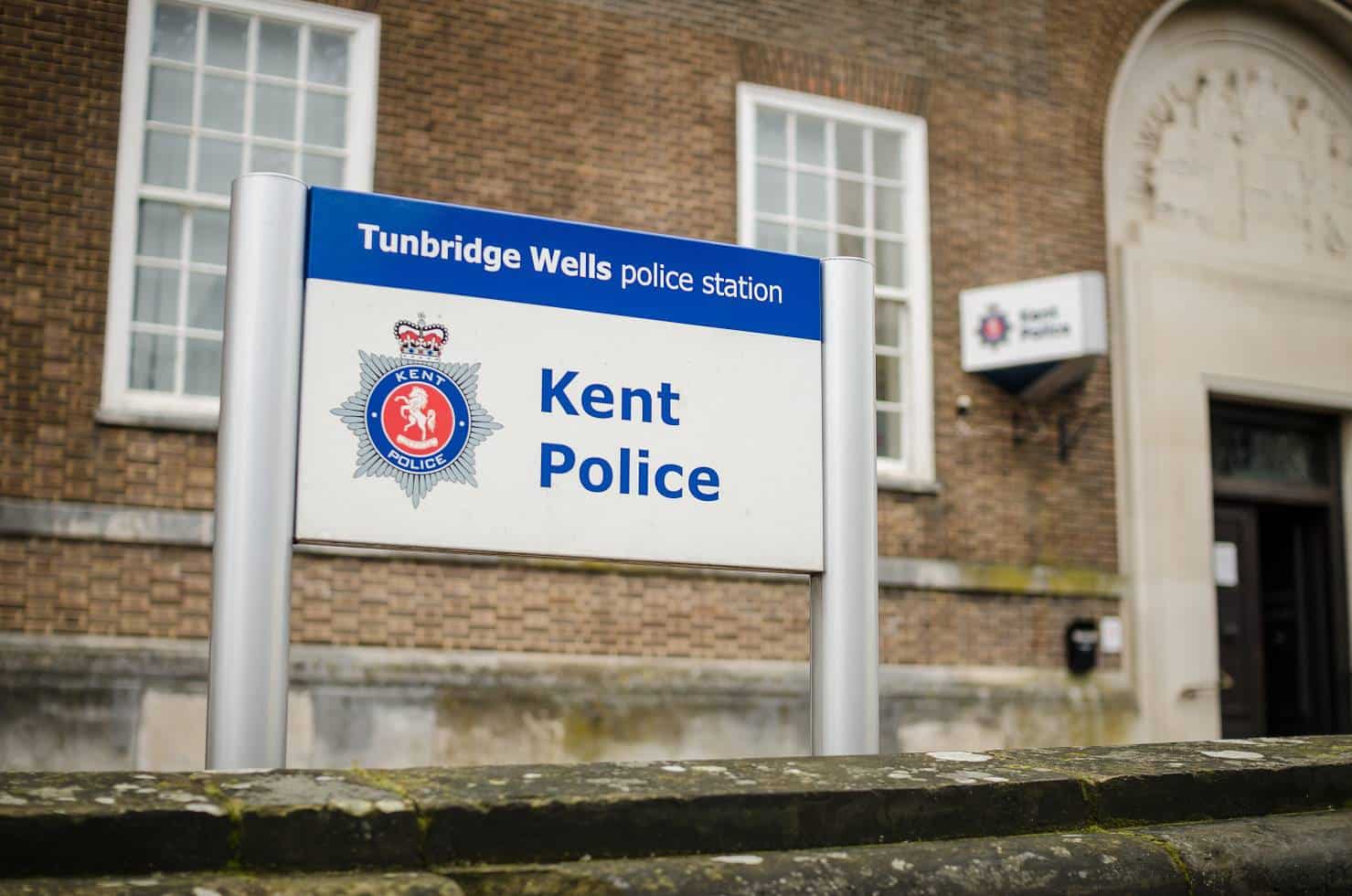CRIME in Tunbridge Wells has risen with the number of incidents recorded up by almost five per cent in a year – but it still remains the safest borough in Kent.
The figures, which cover the 12 month period between October 2015 and September 2016 form part of the latest strategic assessment of the Tunbridge Wells Community Safety Partnership. Members include the borough and county councils, Kent Police and the National Probation Service, among others.
Its findings are used to dictate the partnership’s priorities over the coming year.
Although the borough remains the safest part of Kent overall, incidents of violent crime rose by 13 per cent.
Violent crime is categorised as including; ‘violence against the person’, robbery, and sexual offences.
In total, 1,696 incidents in this category were recorded over the period – equivalent to 14.6 recorded violent crimes per 1,000 population.
Park, Culverden, Sherwood and Southborough and High Brooms are noted to be the top four wards for violence against the person.
Domestic abuse is seen as the main contributing factor in cases of ‘violence against the person’.
Borough-wide figures revealed a six per cent rise in this sub-category over the 12 month period to 1,403 cases, but it remains the lowest in Kent and is highly concentrated. The report states: “A small number of known residential addresses, NTE (night time economy) venues and roads typically account for a high proportion of all offences.”
“It is clear there has been a recent increase in the reporting of historic sexual offences”
The documents also noted a ‘sharp rise’ in sexual offences. In total, 165 incidents classed as a sexual offence were recorded during this period, up from 125 – marking a 32 per cent increase.
Sexual offences accounted for just under 2.2 per cent of total crimes recorded and much of the increase has been attributed to the reporting of historical cases. ,
Documents note most of the increase was concentrated in the latter half of the time period, with ward data for April to November 2016 showing ‘a sharp rise in incidents’ in Park ward and ‘significant rises’ in Hawkhurst, Cranbrook and St James.
The report goes on to state: “Despite some high profile sexual offence cases that made local news headlines in 2016 it is clear there has been a recent increase in the reporting of historic sexual offences. An analysis of sexual offence data for this assessment revealed that of the seven reported sexual offences in Frittenden this year – an unusually high number – five were historic.”
Several categories and sub-categories of crime have seen sharp falls in the number of offences recorded.
The largest fall was a halving in the number of robberies, with 26 incidents recorded, giving Tunbridge Wells the second lowest rate of robberies in the county, behind Tonbridge and Malling.
In addition, there has been a ‘good reduction’ in burglaries of dwellings and burglaries of other premises, which fell by 35 and 13 per cent to a recorded 155 and 311 offences respectively.
Drug related offences dropped by just under 11 per cent to 189 cases, and shoplifting fell by 17 per cent to 436 incidents.
Anti-social behaviour, which is the largest single category, has remained steady, with 2,253 incidents recorded – an increase of under one per cent.
Overall, crime rose by 4.7 per cent in the 12-month period October 2015 – September 2016, with 5,285 crimes reported, a rise of 245 – the smallest increase in Kent.
Per capita, Tunbridge Wells remains the safest place, with 45 crimes per 1,000-residents, less than Tonbridge (50), Sevenoaks (51) and far below the Kent average of 70.
The document notes: “The overall crime picture for the past three years has shown rates of crime and anti-social behaviour to be fairly steady, though with a slight upward trend. This trend follows the Kent district average.”
Who are involved in the Community Safety Partnership?
Tunbridge Wells Borough Council, Kent County Council, Kent Police, Kent Fire and Rescue Service, National Probation Service, Kent Surrey and Sussex Community Rehabilitation Company and the NHS West Kent Clinical Commissioning Group.
Mary Trevillion, CEO at Family Matters, a Kent-based charity that helps victims of sexual abuse, said: the national media coverage of high-profile individuals being convicted for past offences has led to more people coming forward.
More faith in the police to act, better interaction between agencies and the introduction of specialist advisors who remain with the victim throughout the entire process have also helped encourage reporting and reduce the number of people withdrawing from the criminal process.
“There is no one single thing that has led to a rise in the number of cases being reported,” she said.
However, Mrs Trevillion said despite the increase the figures were still ‘understate’ the scale of the problem as many people are still not coming forward. They also fail to show worrying trends in the type of offence.
“At Family Matters we have seen a 249 per cent increase in stranger rape over the last couple of years, which is worrying. Traditionally it has involved people who know each other.”
Kent Police and Crime Commissioner Matthew Scott said: “I welcome the fact that more victims of crimes which historically were under-reported, like domestic abuse and hate crime, are seemingly now more confident in seeking help from the police. It means more vulnerable people can be safeguarded and I will continue to commission services which give victims the very best support suited to their individual needs.
“My Safer in Kent Plan makes fighting crime and antisocial behaviour a priority and I will continue to hold the Chief Constable to account on behalf of the public. Crime data can be a useful reference point but it is only part of the picture. More important is that Kent Police strives to put victims and witnesses first.”
Kent Police Inspector Christian Mayers, from the Tunbridge Wells Community Safety Unit, said: “The Borough of Tunbridge Wells has the lowest level of reported crime across the county and therefore its residents are less likely to be a victim of crime than anywhere else in Kent. Whilst there have been rises in certain offence types, those rises are reflected across Kent and also nationally.
“Nationally, the press coverage of high profile cases involving violent and sexual offences has empowered victims to come forward and report these crimes to the police and have confidence that their reports will be handled sensitively and appropriately.
“Although violent crime has risen over the last year, the reported increase in domestic abuse offences is lower than the rest of the county. The increase in the reporting of sexual offences equates to 40 crimes over the year and one third of the increase is down to historical reporting.
“It is also important to note that other offence types reported have also decreased in number, including burglary dwellings which is down from 240 reported crimes to 155, robberies which have halved from 53 to 26 and burglaries other than dwellings which have reduced from 358 to 311. Drug and theft offences have also fallen.
“Tunbridge Wells is a vibrant and well-visited part of the county which means we attract visitors from outside the district and sometime these can add to reported crimes, such as those that take place during our night time economy.
“But we want people to enjoy Tunbridge Wells and know that it is a safe place to live, work and visit.”
Crime breakdown
| Type of crime | Type of crimes as proportion of offences (%) in Tunbridge Wells | Total number of offences recorded | Position in county (Lower rank indicates fewer crimes) comparison of 12 boroughs |
| Anti-social behaviour | 29.9 | 2253* | 1 |
| Violence against the person | 22.9 | 1723 | Total NA (Domestic abuse 3) |
| Criminal damage | 11 | 826 | 1 |
| Other theft | 10.6 | 801 | NA |
| Shoplifting | 5.8 | 436 | 2 |
| Burglaries other than dwellings | 4.1 | 311 | 4 |
| Public Order offences | 2.7 | 201 | NA |
| Drug Offences | 2.5 | 189 | 9 |
| Theft from motor vehicle | 2.3 | 177 | 1 |
| Sexual Offences | 2.2 | 165 | 3 |
| Burglary of dwelling | 2.1 | 155 | 1 |
| Theft of motor vehicle | 1.2 | 93 | 1 |
| Other crimes | 1.1 | NA** | NA |
| Vehicle interference | 0.6 | NA** | NA |
| Theft of pedal cycle | 0.5 | 37 | 1 |
| Robbery | 0.3 | 26 | 2 |
| Possession of weapons | 0.2 | NA** | NA |
| All crime  | 100 | 5,285 | 1 |
*The overall ‘Level of Crime’ is officially recorded as 5,285 offences – excluding the inclusion of anti-social behaviour. **Individual statistics unavailable

Referendum led to more Hate Crime
Police data for the four weeks prior to and following the EU referendum showed an increase in hate crime across Kent (109 reports during the period before the vote, 172 following the vote). Tunbridge Wells showed an increase in race-based hate crime from four to nine during this period. Religious based hate crime remained steady at two offences prior to and following the 23 June vote.
London’s gangs
The Home Office defines a gang as having one or more characteristics that enable its members to be identified as a group by others. This is a purposefully flexible definition and it is recognised that there needs to be a multi-agency approach to tackle the issue.
One of the main issues for Kent is the use of “county lines” by London street gangs to extend their drug dealing into locations outside their home areas.
The report identifies three London street gangs linked to the borough and a further seven local drug networks have suspected links to these or other London gangs.
Organised crime’s international connection
Organised crime can be defined as serious crime planned, coordinated and conducted by people working together on a continuing basis. Their motivation is often, but not always, financial gain. Organised criminals working together for a particular criminal activity or activities are called an organised crime group.
There are 5 OCGs with a recorded impact in the Tunbridge Wells area. The most common crime types associated with these groups is organised theft. There are groups that also have an impact on other local authority areas and in some cases other counties.
CCTV
The report also states that during one period CCTV monitored a total of 126 incidents graded as violent. It added: “These incidents range from assaults and domestic violence to public order and racial incidents. Violent incidents are routed to the police in real time for immediate attention. CCTV operators bring such incidents to daily briefings for further attention or for feedback from agencies to operators.”
The borough council is set to abandon ‘active monitoring’ of CTTV in place of a ‘passive’ model in order to cut costs, despite objections raised by Kent Police.








